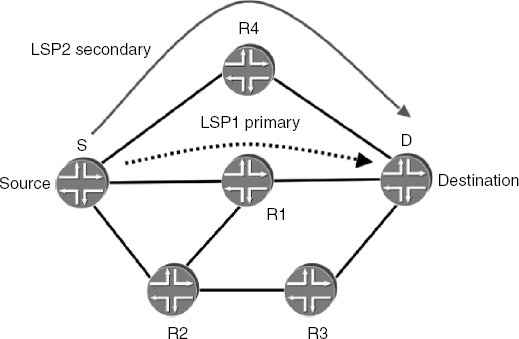3.4. END-TO-END PROTECTION
The first type of protection discussed is end-to-end protection, also known as path protection. Although not as popular as local protection using fast reroute, it is important to examine it because it highlights some of the issues solved by local protection.
A common practice in network deployments is the use of a primary/backup approach for providing resiliency. Following this model, LSP protection is achieved using two LSPs: the primary, used under normal operation, and the secondary, used if there is a failure on the primary. For example, in Figure 3.1 LSP2 (S-R4-D) provides path protection for LSP1 (S-R1-D). For fastest recovery times, the secondary is pres-ignaled and ready to take over the traffic, in effect being in hot standby mode. When a failure (such as an interface down event) is detected on the primary LSP, an RSVP error is propagated to the LSP head end. Upon receipt of this error message, the head end switches the traffic to the secondary. The problem is that until the error reaches the head end, traffic continues to be sent over the primary. If the secondary is not presignaled, the extra time required to set it up further increases the switchover delay.
Figure 3.1. Path protection

From the example, several properties of path protection become apparent.
3.4.1. Control over the traffic flow following a failure
The use of a presignaled ...
Get MPLS-Enabled Applications: Emerging Developments and New Technologies now with the O’Reilly learning platform.
O’Reilly members experience books, live events, courses curated by job role, and more from O’Reilly and nearly 200 top publishers.

